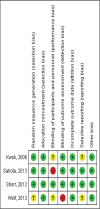Systematic review and meta-analysis of clinical trials: In-hospital use of sensors for prevention of falls
- PMID: 34731123
- PMCID: PMC8519232
- DOI: 10.1097/MD.0000000000027467
Systematic review and meta-analysis of clinical trials: In-hospital use of sensors for prevention of falls
Abstract
Background: Intra-hospital falls have become an important public health problem globally. The use of movement sensors with alarms has been studied as elements with predictive capacity for falls at hospital level. However, in spite of their use in some hospitals throughout the world, evidence is lacking about their effectiveness in reducing intra-hospital falls. Therefore, this study aims to develop a systematic review and meta-analysis of existing scientific literature exploring the impact of using sensors for fall prevention in hospitalized adults and the elderly population.
Methods: We explored literature based on clinical trials in Spanish, English, and Portuguese, assessing the impact of devices used for hospital fall prevention in adult and elderly populations. The search included databases such as IEEE Xplore, the Cochrane Library, Scopus, PubMed, MEDLINE, and Science Direct databases. The critical appraisal was performed independently by two researchers. Methodological quality was assessed based on the ratings of individual biases. We performed the sum of the results, generating an estimation of the grouped effect (Relative Risk, 95% CI) for the outcome first fall for each patient. We assessed heterogeneity and publication bias. The study followed PRISMA guidelines.
Results: Results were assessed in three randomized controlled clinical trials, including 29,691 patients. A total of 351 (3%) patients fell among 11,769 patients assigned to the intervention group, compared with 426 (2.4%) patients who fell among 17,922 patients assigned to the control group (general estimation RR 1.20, 95% CI 1.04, 1.37, P = .02, I2 = 0%; Moderate GRADE).
Conclusion: Our results show an increase of 19% in falls among elderly patients who are users of sensors located in their bed, bed-chair, or chair among their hospitalizations. Other types of sensors such as wearable sensors can be explored as coadjutants for fall prevention care in hospitals.
Copyright © 2021 the Author(s). Published by Wolters Kluwer Health, Inc.
Conflict of interest statement
The authors have no conflicts of interest to disclose.
Figures




References
-
- World Health Organization No344.2010. http://www.who.int/mediacentre/factsheets/fs344/es/index.html. Accessed May, 2012.
-
- The Joint Commission Falls. 2010, July Prevention Available at: http://www.jointcommission.org/Speak_Up Reduce_Your_Risk_of_Falling. Accessed May 12, 2012.
-
- Registred Nurses’ Association of Ontario. Prevention of falls and fall injuries in the older adult (Reviewed November 2019). Toronto, Canada: Registered Nurses’ Association of Ontario; 2017.
-
- National Institute for Health and Care Excellence Falls. Assessment and prevention of falls in older people (Revised November 2019). Available at: http://nice.org.uk/guidance/CG161. Accessed November, 2011.
Publication types
MeSH terms
Grants and funding
LinkOut - more resources
Full Text Sources
Medical

